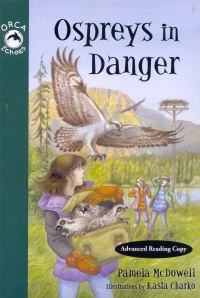| ________________
CM . . .
. Volume XX Number 32. . . .April 18, 2014
excerpt:
Ospreys in Danger is author Pamela McDowell's fictionalized account of the search for a creative solution to stop ospreys, birds of prey, from nesting on top of power poles in Alberta. In this story, nine-year-old best friends Cricket and Shiloh discover that the cause of a power outage in their town is a fire on top of a power pole in the woods. It is the same power pole that they knew to be occupied by an osprey nest. Cricket's father, the warden in the park, assigns Cricket to find the osprey chicks that would have been in the nest. She and her friend find and are put in charge of caring for three baby ospreys until arrangements are made to repair the burned nest.
The story comes to a satisfactory conclusion when a classmate of Shiloh and Cricket's designs a power pole with a platform on top for nesting instead of transformers and power cables. They show this model to the power company workers who eventually build a similar contraption in the woods in the same area as the original power pole that burned down. Finally, the osprey parents, who have never left the area, return to the platform where their baby chicks have been placed, and they begin to build a new nest. The power company in this story is FortisAlberta; the story is based on true events from 1977 when a power pole fire from an osprey nest knocked out power to an Alberta town. The power company has worked to move power lines out of the osprey nesting areas and to build nesting platforms like the one described in this book to accommodate the needs of the birds. Author McDowell has done of fine job of telling an interesting and immediate story to children who are becoming interested in environmentalism and who can connect to events in this story. Power poles are everywhere, and birds' nests are also everywhere at this time of year. An experienced chapter book reader in grade two or three can easily handle the language in this book. Kasia Charko's illustrations add increased meaning to the text as they give readers more access to what an osprey looks like, what the environment looks like, and especially what a power pole looks like to make the problem in this book make sense. Recommended. Robert Groberman is a grade one teacher at Katzie Elementary School in Surrey, BC.
To comment
on this title or this review, send mail to cm@umanitoba.ca.
Copyright © the Manitoba Library Association. Reproduction for personal
use is permitted only if this copyright notice is maintained. Any
other reproduction is prohibited without permission.
NEXT REVIEW |
TABLE OF CONTENTS FOR THIS ISSUE
- April 18, 2014.
AUTHORS |
TITLES |
MEDIA REVIEWS |
PROFILES |
BACK ISSUES |
SEARCH |
CMARCHIVE |
HOME |

 Cricket takes the osprey chicks home, and, after many failed attempts to feed them food they won't eat, Cricket's older brother finds an encyclopedia article which says that ospreys only eat fish. And so they go fishing to keep the baby birds fed.
Cricket takes the osprey chicks home, and, after many failed attempts to feed them food they won't eat, Cricket's older brother finds an encyclopedia article which says that ospreys only eat fish. And so they go fishing to keep the baby birds fed.